The Chronicles of Virtual Table Table (a.k.a VTT)
In this article, we’re going to see how virtual inheritance works under the hood. To understand it, we will need to go deeper into the Itanium C++ ABI. We’ll reverse its hidden structures and watch how it keeps diamond inheritance from turning into a havoc. Lets start!
To get started, first lets get familiar, deeply familiar with a VTT.
And… What exactly is a VTT?
Virtual Table Table, VTT, as defined in the Itanium C++ ABI specification:
“An array of virtual table addresses, called the VTT, is declared for each class type that has indirect or direct virtual base classes.
We’ll take the following example from the Itanium ABI to explain the VTT:
class A1 { int i; };
class A2 { int i; virtual void f(){} };
class V1 : public A1, public A2 { int i; };
// A2 is primary base of V1, A1 is non-polymorphic
class B1 { int i; };
class B2 { int i; };
class V2 : public B1, public B2, public virtual V1 { int i; };
// V2 has no primary base, V1 is secondary base
class V3 {virtual void g(){} };
class C1 : public virtual V1 { int i; };
// C1 has no primary base, V1 is secondary base
class C2 : public virtual V3, public virtual V2 { int i; };
// C2 has V3 primary (nearly-empty virtual) base, V2 is secondary base
class X1 { int i; };
class C3 : public X1 { int i; };
class D : public C1, public C2, public C3 { int i; };
which gives us an inheritance structure like…
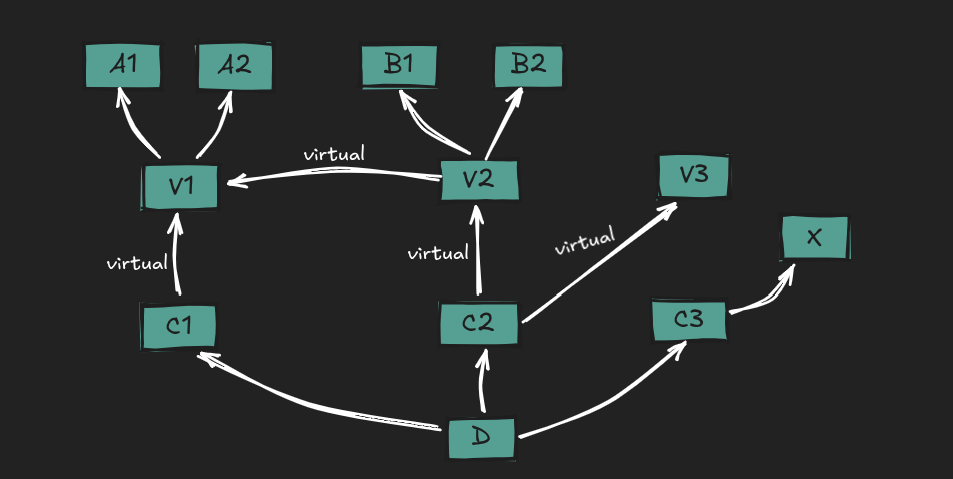 Lets take a look at the VTT created for this example by IDA.
Lets take a look at the VTT created for this example by IDA.

Dissecting VTT’s layout…
It has a number of entries… Lets crack each entry. According to the VTT layout as described by Itanium ABI,
The elements of the VTT array for a class
Dare in this order:1- Primary virtual pointer: address of the primary virtual table for the complete object
D.2- Secondary VTTs: for each direct non-virtual proper base class
BofDthat requires a VTT, in declaration order, a sub-VTT forB-in-D, structured like the main VTT forB, with a primary virtual pointer, secondary VTTs, and secondary virtual pointers, but without virtual VTTs.
NOTE: This construction is applied recursively.3- Secondary virtual pointers: for each base class
Xwhich (a) has virtual bases or is reachable along a virtual path fromD, and (b) is not a non-virtual primary base, the address of the virtual table forX-in-Dor an appropriate construction virtual table.4- Virtual VTTs: For each proper virtual base class in inheritance graph preorder, construct a sub-VTT as in (2) above.
NOTE: The virtual VTT addresses come last because they are only passed to the virtual base class constructors for the complete object.
Lets see, if the VTT we got from IDA, really does conform to these rules or not. The first entry in our VTT unk_3A18should point to the primary virtual table of our object.
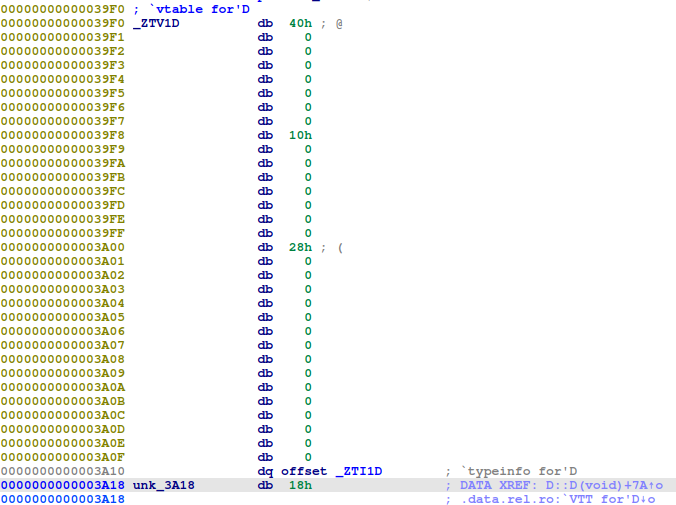
and we see, it does bring us to the vtable for D.
After our first entry for the primary virtual table for the complete object, now come the Sub-VTT, which are actually construction tables.
what on earth is a construction table?
There is a problem, and that is that a normal virtual table for a base class may not have the right information like virtual base offsets which are needed to access virtual bases of the complete object, because the offsets of a virtual base can of course be different between a base class object and the same base class when it’s part of a derived class. And to resolve this, a construction virtual table is created, which is our Sub-VTT, which contains the necessary information that makes sure that virtual calls and RTTI queries resolve correctly during the construction and destruction of base class subobjects.
When a base class subobject is being created, the object temporarily behaves like that specific base class even if its not, and as a result, RTTI queries and virtual calls within the base class constructor will resolve to the base class’s functions, and not the complete derived class’s functions. Enough on why we need Sub-VTT’s, lets move forward now..
Now we see, that D inherits from C1, C2 and C3 in the following order:
class D : public C1, public C2, public C3 { int i; };
The specification says:
For each direct non-virtual proper base class B of D that requires a VTT, add a sub-VTT for B-in-D.
C1 is a direct proper base of D and has a virtual base (V1), so C1 requires a VTT. Therefore, we see D’s VTT having an entry for C1-in-D.
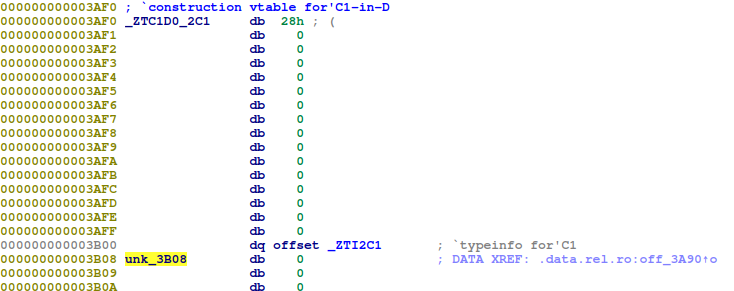
and it brings us right inside our C1-in-D construction vtable, at an offset right below our typeinfo for C1. So till now, we have a VTT like…

Lets jump to the third entry (actually 2nd since we’re dealing with 0 based indexing) at 0x3A98 (off_3B20) now which brings us inside our C1-in-D again…
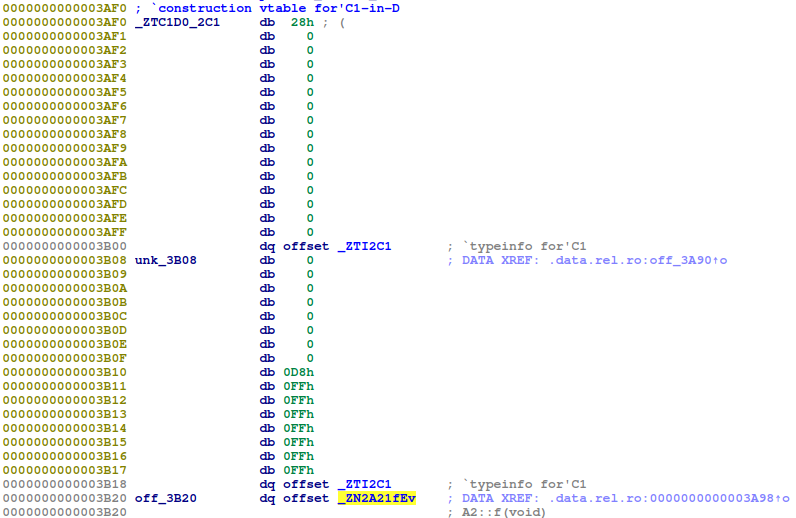
This introduces us to the secondary vptr.
Meet the Secondary vptrs
In the specification, it says…
For each base class X which (a) has virtual bases or is reachable along a virtual path, and (b) is not a non-virtual primary base, include the address of X-in-D.
… a secondary vptr needs to be created. and what is a virtual path…
X is reachable along a virtual path from D if there exists a path X, B1, B2, …, BN, D in the inheritance graph such that at least one of X, B1, B2, …, or BN is a virtual base class.
Here, V1 is a virtual base of C1, so C1’s sub-VTT contains a secondary virtual pointer for V1-in-C1 in D. Lets demangle it, and get the name for the entry at offset off_3B20.
off_3B20 dq offset A2::f(void)
Recall, that V1 inherited from both A1 and A2….
class V1 : public A1, public A2;
… and A2 is the primary base of V1 because A2 is a polymorphic class (has virtual functions) and is inherited non-virtually at offset 0 in V1’s object layout. Since V1 places A2 at the beginning of its memory layout, V1’s vptr shares the same location as A2’s vptr, allowing them to use the same vtable, and this is why A2::f() appears as the first virtual function entry in V1’s vtable. A2 occupies the primary base position at offset 0, making it V1’s primary base class.

Till now in the VTT, we’ve set up the primary vptr that points to D’s vtable at [0] and then Sub VTT or construction table for C1-in-D:
- The first slot [1] points to the construction vtable for the
C1part ofD. - The second slot [2] points to the secondary vptr for
V1-in-C1-in-D.
Down the Rabbit Hole of it all…
Lets deep dive in it so that the reason of creating a VTT becomes clearer… During D’s construction, D’s constructor first constructs virtual base V1 directly, and then constructs C1 subobject. C1’s constructor gets a pointer to C1-in-D (D_VTT[1]) which points to the sub-VTT for C1-in-D. C1’s constructor uses D_VTT[1] to set its vptr and then uses D_VTT[2] which is V1-in-C1 in D secondary vptr. If we take a look at the disassembly of C1’s constructor:
push rbp
mov rbp, rsp ;function prologue
mov [rbp+this], rdi
mov [rbp+C_in_D], rsi
mov rax, [rbp+C_in_D] ;rax = C_in_D pointer
mov rdx, [rax] ;rdx = qword at C_in_D Sub-VTT
mov rax, [rbp+this] ;rax = this
mov [rax], rdx ;*(this) = primary_vptr
mov rax, [rbp+this] ;rax = this
mov rax, [rax] ;rax = value stored in object (C-in-D)
sub rax, 18h ;rdx = -24 offset from where we currently are
So if we remember, we landed at 0x3B08 following our C1-in-D entry in the VTT. Our rax so far stores the address 0x3B08, and when we go back 24 bytes, we reach at 0x3AF0, where we have 28h…
mov rax, [rax] ;rax = qword located at C-in-D - 0x18 = 28h
mov rdx, rax ;rdx=rax so rdx=0x28
mov rax, [rbp+this] ;rax=this
add rdx, rax ;move forward 28h from where we currently are
mov rax, [rbp+C_in_D] ;rax=C-in-D
mov rax, [rax+8] ;Reach the entry V1-in-C1 in D in Sub-VTT
mov [rdx], rax ;move V1-in-C1 at offset 0x28 from actual this.
pop rbp
retn
Now our C1 has correct virtual base offsets for the C1-in-D context and it resets the shared virtual base V1’s vptr to ensure correct virtual dispatch during C1’s construction phase… V1’s vptr will be updated again by subsequent constructors (C2, then D).
Lets move to our next entry now.

our fourth (technically third) entry at 0x3AA0 in the VTT (off_3B58) brings us to C2-in-D.
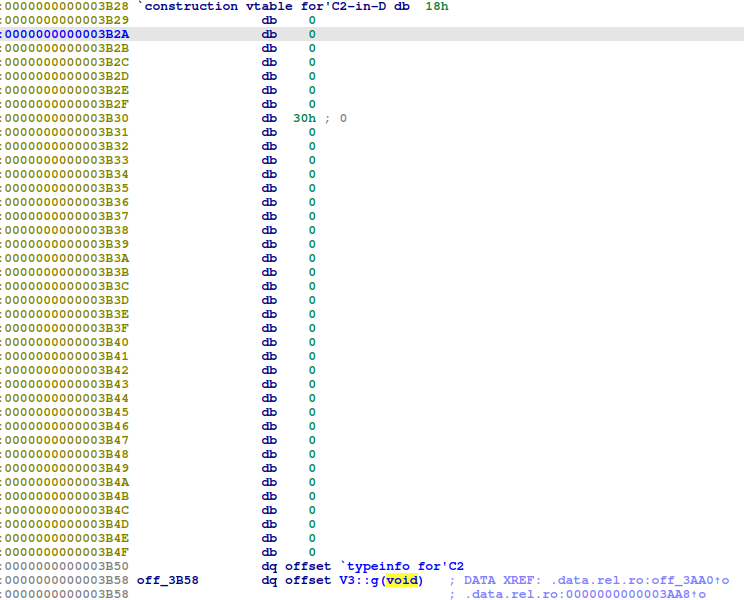
We know why it’s here.. Because we need to create a sub-VTT B-in-D for each direct non-virtual proper base class B of D. D inherits directly from C1, is a proper base, and has a virtual base V1, so we create C2-in-D.

Now at our fifth entry (technically fourth), we have off_3B58 which brings us to…

We’ve already seen that off_3B58 is inside our construction table C2-in-D. It points at V3::g(void), means V3 is our primary base for C2, so V3-in-C2 is a primary vptr (look into this). This is because we can clearly see that C2 is sharing its virtual table with V3. Our entry for Sub-VTT C2-in-D was also at off_3B58, and the entry immediately after it in the main VTT is also off_3B58, so we can safely conclude that V3-in-D is our primary vptr. Also, according to the Itanium ABI, a primary class is..
If C has a dynamic base class, attempt to choose a primary base class B. It is the first (in direct base class order) non-virtual dynamic base class, if one exists. Otherwise, it is a nearly empty virtual base class, the first one in (preorder) inheritance graph order which is not an indirect primary base class if any exist, or just the first one if they are all indirect primaries.
A nearly empty virtual base class is…
A class that contains a virtual pointer, but no other data except (possibly) virtual bases. In particular, it:
- has no non-static data members and no non-zero-width unnamed bit-fields,
- has no direct base classes that are not either empty, nearly empty, or virtual,
- has at most one non-virtual, nearly empty direct base class, and
- has no proper base class that is empty, not morally virtual, and at an offset other than zero. Such classes may be primary base classes even if virtual, sharing a virtual pointer with the derived class.
V3 completes the checklist for a nearly empty class. If we see the preorder traversal for our inheritance hierarchy, it comes as…
inheritance graph order The ordering on a class object and all its subobjects obtained by a depth-first traversal of its inheritance graph, from the most-derived class object to base objects, where:
- No node is visited more than once. (So, a virtual base subobject, and all of its base subobjects, will be visited only once.)
- The subobjects of a node are visited in the order in which they were declared. (So, given
class A : public B, public C, A is walked first, then B and its subobjects, and then C and its subobjects.) Note that the traversal may be preorder or postorder. Unless otherwise specified, preorder (derived classes before their bases) is intended…
Since we are supposed to do a depth first traversal from the most derived class object to base objects, so we turn our graph upside down, unlike the trees/graphs in basic data structures where we start from our root node which is usually the parent and go down to its children nodes. And all the remaining preorder depth first traversal rules are applied.
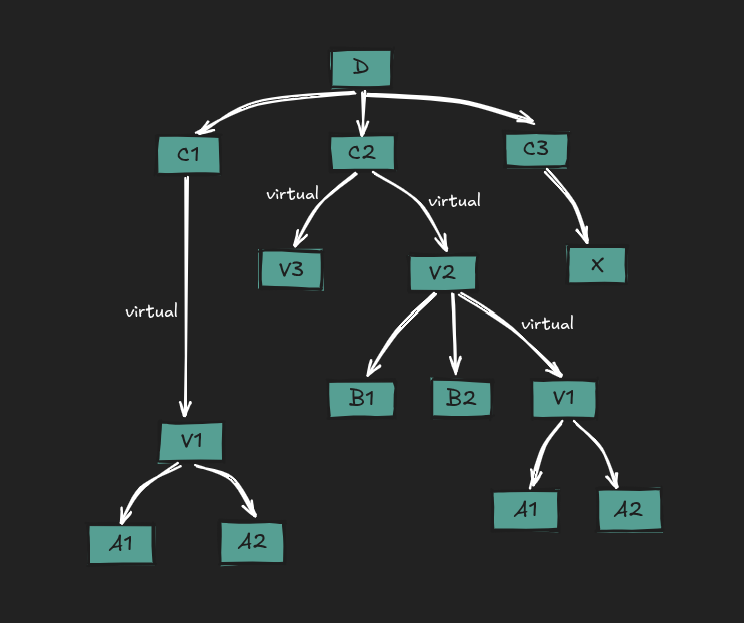
The preorder traversal for this graph would be:
D -> C1 -> V1 -> A1 -> A2 -> C2 -> V3 -> V2 -> B1 -> B2 -> C3 -> X1
We see, that V3 also comes before V2 in the preorder, so now we can safely conclude that V3 is the primary base for C2… So now…
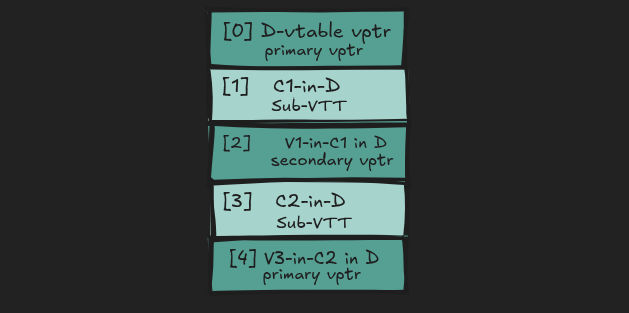
Lets jump to our sixth entry (technically 5th)…

It points at unk_3B78.
Rule 2 from the specification said that for each direct non-virtual proper base class B of D that requires a VTT, in declaration order, a sub-VTT for B-in-D, structured like the main VTT for B, with a primary virtual pointer, secondary VTTs - stop right there! We’ve seen C2’s primary virtual pointer, but we aren’t going to see any secondary VTT here, because C2 has no direct non-virtual proper base class as stated in the rules. But we might have secondary virtual pointers here…We know according to rule 3 that we have a secondary virtual pointers for each base class X which…
(a) has virtual bases or is reachable along a virtual path from D, and
(b) is not a non-virtual primary base.
C2 inherits virtually from 2 base classes…
class C2 : public virtual V3, public virtual V2 { int i; };
…V3 and V2. V3 won’t get a secondary vptr, since it’s our primary base.. Moving on to V2, it does have a virtual base, and it is not a non-virtual primary base for C1, so it gets a secondary vptr. If we follow unk_3B78, it brings us to the entry V2-in-C2 in D.
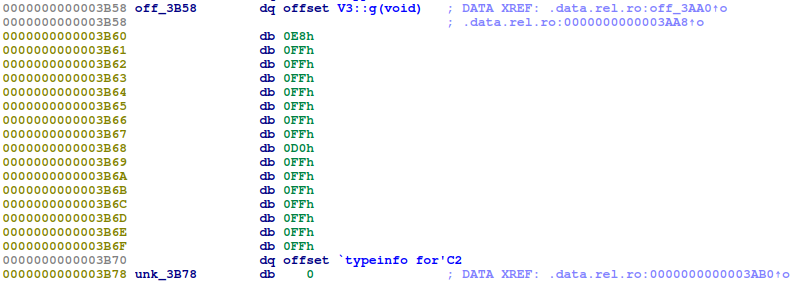
This is where it brings us, right at off_3B78, below the typeinfo which we see in Construction table C2-in-D for the second time, and above it is a negative offset which is a vcall offset for virtual inheritance adjustments.

But our secondary vptrs don’t actually stop here, because V2 inherits from V1. This brings us to the 7th (technically 6th) VTT entry, which makes us land at off_3B90.

and it takes us to V1-in-C2.

We see A2::f(void), well that’s because V1 inherits from A2 and A2 has a virtual function f(void). V1 gets a secondary vptr because firstly it’s reachable along a virtual path, and secondly it’s not a non-virtual primary base of C2. If we go up the inheritance hierarchy, we don’t stop at V1 alone, but go upto A1 and A2 classes too, since V1 inherits from them.. not only this, but V2 also inherits from B1 and B2, but we’re not going to have secondary vptrs for them..
A1 is direct base of V1. It doesn’t have virtual bases, but it is reachable along a virtual path from D. Also, it is not a non-virtual primary base. So it completes all the requirements for having a secondary vptr, but A1 itself is non-polymorphic (no virtuals at all). So A1 does not even need a vptr and hence no entry in the VTT.
ForA2, its a base of V1 and is polymorphic. It is also reachable along a virtual path. But! we know that primary non-virtual bases don’t get secondary vptrs. And inside V1, A2 is the primary base (polymorphic and also comes first in preorder), so no entry is going to be created for that.
As far as B1 and B2 are concerned, they are non virtual and non-polymorphic, so no entry!

Our third base D inherits from is C3. And C3 doesn’t even get a Sub-VTT, because it has no direct or indirect virtual bases.
More secondary vptrs
Now since we are done with Sub-VTT’s for our main VTT, next come the secondary virtual pointers. You might have noticed, We had followed the same layout for our Sub-VTT’s, as we have been doing for the main VTT. This is what we meant by being recursive in point 2, with the exception of Virtual VTT’s (Virtual virtual table table, good heavens), which we’ll later see.

Now we are at the 8th entry (technically 7th), which takes us to…

We see that it’s inside secondary vtable in D’s vtable. It’s V1-in-C2 in D. Actually (V1 is a not a non-virtual primary base and it is reachable along a virtual path)…. One thing to remember, is that we can’t have a secondary vptr to C1-in-D, because it’s the primary base for D.
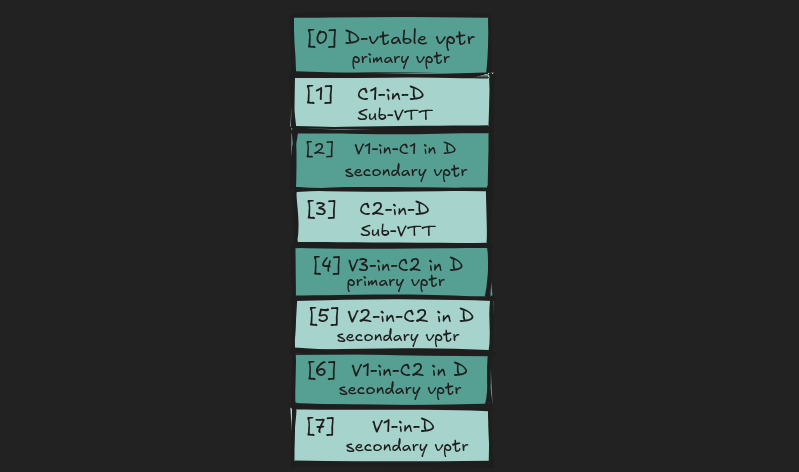
Later comes entry at off_3A48 which is our 9th (technically 8th) entry…

which brings us here…..

This is C2-in-D.. C2 is not reachable via a virtual path, but it does have virtual bases, and it is not the non-virtual primary base for D, so it gets an entry. The V3::g(void) we see here, is the virtual function which was declared and defined in V3, which is inherited by C2.
Jumping on to our 10th (technically 9th) VTT entry which as we can see in the above screenshot, is again off_3A48. This is our V3-in-D. We see that the V3-in-D entry will be the same as the C2-in-D entry. Again, V3 is reachable along a virtual path and is definitely not D’s primary non-virtual base.
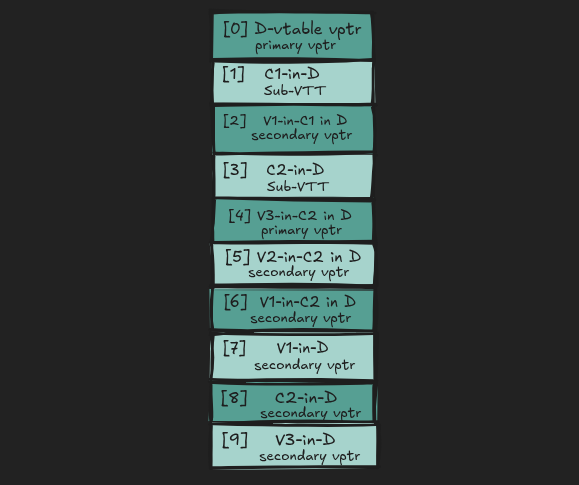
Now onto our 11th (technically) VTT entry… which should theoretically be a secondary vptr to V2-in-D, but that’s missing in the VTT compiler generated for my binary. The reason can possibly be a compiler optimization, as we’ll soon see, where the Virtual VTT entry [11] serves the purpose that a V2-in-D secondary virtual pointer would have served. Now since we’re done with our secondary vptrs, we’ll move on to our fourth point, which as I just mentioned, is the virtual VTT.
The unsung heroes: Virtual VTT
Virtual VTTs: For each proper virtual base classes in inheritance graph preorder, construct a sub-VTT as in (2) above.
The Virtual VTT’s are required to be constructed just as we construced our Sub-VTT’s. Their addresses come at the end of the VTT because they are only passed to the virtual base class constructors for the complete object. According to the specification Rule 3:
A virtual base with no virtual bases of its own does not require a VTT, but does require a virtual pointer entry in the VTT.
This means, a class needs a VTT when it has to deal with virtual base class construction, which requires multiple vtable addresses at different stages of construction, otherwise it’s not needed. So only those of our virtual bases classes will need a virtual VTT, which themselves have virtual bases.
The virtual bases we have are V1, V2 and V3. From these, only V2 is a virtual base which itself is inheriting virtually from V1, hence it’ll get a virtual VTT entry in the main VTT. Moving forward with our VTT in IDA:

following the offset unk_3BB0 brings us to….
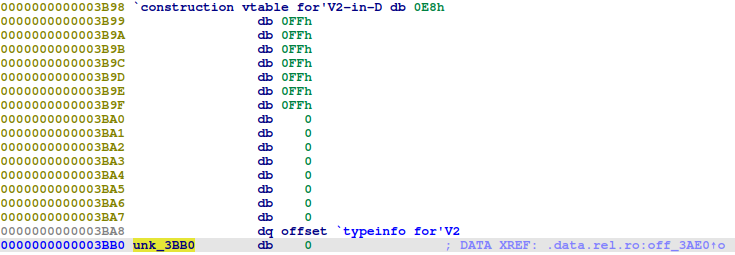
which indeed is our Virtual VTT.
Again applying the same rules here… For Virtual VTT of V2-in-D, we have our primary vptr (look into this)pointing to offset 0x3BB0. Which checks our rule 1, that the first entry needs to hold the address of the primary virtual table… For rule 2, since we don’t have any direct non-virtual proper base class B of D that requires a VTT, we won’t create any. For rule 3, of having secondary vptrs, since V1 is reachable along a virtual path, and is not the primary base for V2, because neither is it non-virtual, nor is it nearly empty because of its data member i which is an integer, so we are going to have a V1-in-V2 in D entry, and we aren’t going to have a virtual VTT for it.. Lets take a look at the final entry of our main VTT in IDA for this:

going over to off_3BC8:
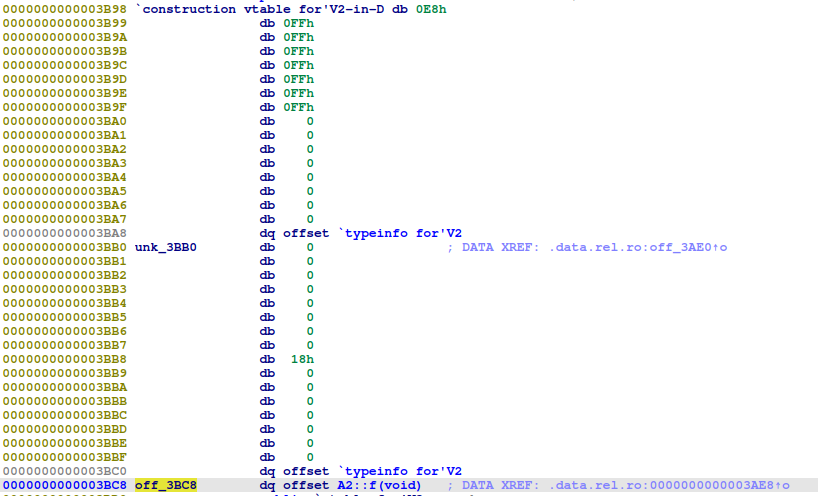
We reach inside our construction vtable for V2-in-D. Why can we see A2:f(void), well that is because A2 has a virtual function f(void), which gets inherited by V1.

Had the A’s tried to be sneaky..
Had either A1 or A2 been virtual bases, we would’ve had some more entries in our VTT. We then would’ve had another Virtual VTT for V1-in-D, more secondary vptrs etc.
Making the diamond behave…
Now lets take a look at how we solve the diamond problem using virtual inheritance. This is the same example used in [[Parents & Children in C++]], with one difference, that here we’ve used the virtual keyword while inheriting from class A.
class A {
public:
int var_a;
virtual void foo() { }
};
class B : virtual public A {
public:
int var_b;
virtual void baz() { }
};
class C : virtual public A {
public:
int var_c;
virtual void bar() { }
void foo() { }
};
class D : public B, public C {
public:
int var_d;
virtual void qux() { }
};
int main() {
D obj;
return 0;
}
Firstly our object obj resides at 0x7fffffffde50 on the stack.

From main we call our D’s constructor…
mov rdi, rax ; this
call D::D(void)
and then from D, we invoke A’s constructor first of all with an addition of 0x20 to our object’s starting address, rather than of D’s base class B and C, thanks to virtual inheritance.
mov rax, [rbp+this]
add rax, 20h ; ' '
mov rdi, rax ; this
call A::A(void)
and then inside A’s constructor, obj stores the address of our A’s vtable (grandparent class) where our this pointer is, at 0x7fffffffde70.
mov [rbp+this], rdi
lea rdx, off_3D18
mov rax, [rbp+this]
mov [rax], rdx
Seeing our vtable in IDA

This makes our object look like..

Then on returning from A::A():
call A::A(void)
mov rax, [rbp+var_8]
lea rdx, off_3C50
mov rsi, rdx
mov rdi, rax ; this
call B::B(void)
We see that rdi has the address of our object obj at 0x7fffffffde50, and we set rsi as 0x555555557c50.

If we analyze the contents at rsi, we see that..

The constructor for the complete class D, passes to its proper base class B constructor a pointer to the appropriate place in the VTT where the proper base class B constructor can find its set of virtual tables. Here’s where VTT has stepped in, lets take a look at how it looks like:

- The first entry at
0x3C48, holds a pointer to the address of the primary virtual table for the complete objectD. - The second entry at
0x3C50, holds our sub-VTT,B-in-D.Binherits virtually fromA, so it requires a VTT of its own then, so at0x3C50, is ourB-in-D’s construction table. - The third entry is basically our secondary vptr in the construction table
B-in-D. As we’ll see ahead, it’ll be holding a reference toA::foo(void).A-in-B in Dgets to be our secondary vptr because firstly, it’s reachable through a virtual path, and secondly, it’s not a primary base for B. This is because it is virtual and it also not nearly empty because of the presence of ` int var_a`. - The fourth entry is our
C-in-DSub-VTT. It is needed, becauseChas virtual bases. - The fifth entry is our secondary vptr for the construction table
C-in-D. We’ll too see this ahead that it holds a reference to a thunk forC::foo(), becauseCis overridingA’sfoo(). Again it’s needed, because all the conditions are satisfied as we’ve discussed above, to makeA-in-C in Dour secondary vptr. (check overriding) - The sixth entry is again a pointer to our
thunk C::foo(), consider itA::foo(), overridden byC::foo(), which is actually true. - The final seventh entry is our
C-in-Dsecondary vptr. We don’t noticeBanywhere in our secondary vptr list, well that’s becauseBisD’s primary base, since it’s non-virtual and comes first in the inheritance order.
Lets dig into the disassembly. We are sending the address of B-in-D construction table as our argument to B’s constructor. Below is the disassembly for B’s constructor.
mov [rbp+this], rdi
mov [rbp+vtable_D], rsi
mov rax, [rbp+vtable_D]
mov rdx, [rax]
mov rax, [rbp+this]
mov [rax], rdx
We see that it stores the address where [rbp+vtable_D] points to at the address of our object stored in rax. This makes our object look like…

where the address at 0x7fffffffde50 is the address of our construction table B-in-D. Moving on with our B’s constructor..
mov rax, [rbp+this]
mov rax, [rax]
sub rax, 18h
mov rax, [rax]
mov rdx, rax
We notice we’re getting the address of our sub VTT B-in-D, going back 24 bytes, and storing whatever we get in rdx.

We see that it has taken us to the very start of the construction table…

We pick the 20h from here, and…
mov rax, [rbp+this]
add rdx, rax
mov rax, [rbp+VTT_D]
mov rax, [rax+8]
mov [rdx], rax
Add it to our this pointer, which takes us to 0x7fffffffde70 again.. And then we add to off_3C50, which was our pointer to construction table B-in-D, an offset of 8, which bring us to 0x3C58..

Which is where A::foo(void) is at… We’ve replaced the memory where A’s constructor had previously written its vtable’s address, with the address of A in sub-VTT B-in-D, making our object now look like…

Great! Now lets return back to D’s constructor.
mov rax, [rbp+var_8]
add rax, 10h
lea rdx, off_3C60
mov rsi, rdx
mov rdi, rax ; this
call C::C(void)
now we’ve added 0x10 to our object’s address, which brings us to 0x7fffffffde60, and load the address at off_3C60 in rdx, which probably now would be our pointer to construction table C-in-D inside our VTT for D, since next we’re calling C’s constructor.

it’s the 4th entry in our VTT, and it does take us to…
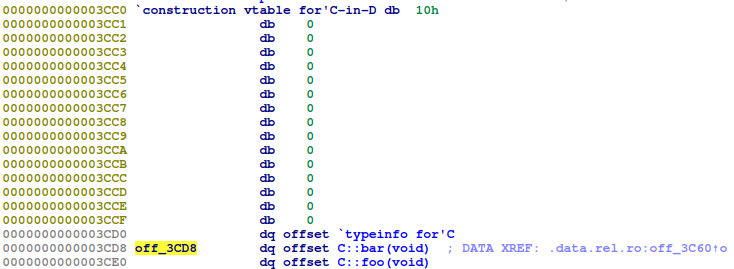
Lets also confirm this stuff in GDB:

This is the address of the first virtual function in C. Great, lets dig into C()’s disassembly.
mov [rbp+this], rdi
mov [rbp+VTT_D], rsi
mov rax, [rbp+VTT_D]
mov rdx, [rax]
mov rax, [rbp+this]
mov [rax], rdx
We’re simply storing the address of our construction table C-in-D in our object.
mov rax, [rbp+this]
mov rax, [rax]
sub rax, 18h
mov rax, [rax]
mov rdx, rax
And now, we’re simply getting the contents at where our this pointer points to right now, which is 0x7fffffffde60, and subtracting 24 again (0x18)… The memory contents at 0x7fffffffde60 point to off_3CD8, which we earlier saw is an offset where our C::bar(void) is, and subtracting 0x18 from it brings us to 0x3CC0, which is right the start of our construction table.

So we’re basically get the 16 from here, 0x10, which is our offset to A’s part in our object from C.

we just got a confirmation from GDB. Lets continue with the disassembly..
mov rax, [rbp+this]
add rdx, rax
We add the offset to our this pointer… landing at..

and then…
mov rax, [rbp+VTT_D]
mov rax, [rax+8]
mov [rdx], rax
We’re simply rewriting some address, at an offset of +0x08 from our construction table C-in-D, at the area A entries have occupied till now..

It brings us to 0x3C68, which holds a pointer to…

It’s simply a thunk to C::foo(void), which was initially A::foo(void), overridden by C. So our object now looks like…

Where we have two new entries, 0x0000555555557cd8 which is our C::bar(void), inside our sub-VTT C-in-D, and 0x0000555555557d00, which is the thunk to C::foo(void) we just saw. Lets return to D’s constructor now, where D things will come into action.
lea rdx, off_3BF0
mov rax, [rbp+var_8]
mov [rax], rdx
At off_3BF0, we have..
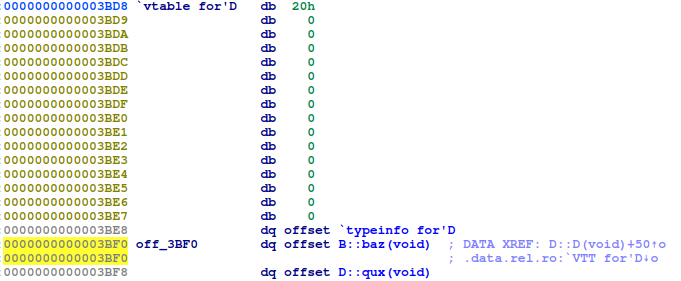
and we’re simply replacing our old entry 0x0000555555557c98, which we’ve just seen in the GDB dump, which was actually the address of the construction table of B-in-D which further pointed to B::baz(void), with the entry of B::baz(void) in our vtable for D. This also shows us, that B is the primary base class for D, since it shares the virtual table slot with it at offset 0. So now our object seems something like…

with a new entry at the start of the object… moving further..
mov rax, [rbp+this]
add rax, 20h ; ' '
lea rdx, off_3C40
mov [rax], rdx
We now jump to 0x7fffffffde70 by adding 0x20 to our object’s starting address, get some stuff at off_3C40, and dump it in our object.

which is actually again our thunk to C::foo(void), but this time in our vtable for D, unlike before where it was in C-in-D construction table.

and now we see a new address, address to our thunk in D’s vtable, at 0x7fffffffde70. Continuing with our disassembly…
lea rdx, off_3C18
mov rax, [rbp+this]
mov [rax+10h], rdx
lets go to off_3C18

which is again, inside our D’s vtable, making our object giving a final look like:

So now we’ve how virtual inheritance is taming classes… but before wrapping up, lets take a look at how each of the typeinfo for our classes would look like..
typeinfo, not your average table…
Firstly if we see our typeinfo for class A:

We see the type is __class_type_info, and below that we have our char *__name which gets inherited by __class_type_info from __type_info as we’ve already seen in Parents and Children in C++, and then we have the typeinfo name for A. Pretty straightforward… Lets see our typeinfo for B.
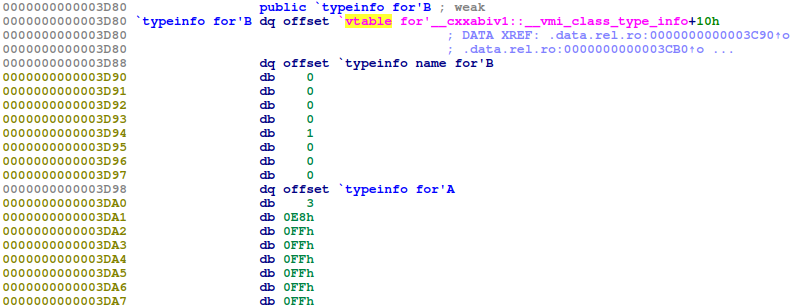
Since our class B inherits virtually from class A, so we see the our typeinfo object type is __vmi_class_type_info, and its vptr points to the vtable of __vmi_class_type_info(as can be seen at 0x3D80) (see The Virtual Functions). The +0x10 we see, skips the RTTI pointer in the vtable itself. This means, our object is going to further hold of course, the typeinfo name, as __vmi_class_type_info inherits from __class_type_info which further inherits the *__name from __type_info and passes it down to its children, as well as unsigned in __flags which carries the details about the class hierarchy, unsigned int __base_count, which tells us the number of direct bases, and __base_class_type_info __base_info[1] (add this to virtual functions) which actually uses a technique called struct hack, to create a variable length array at the end of the class. Despite being declared as an array of size [1], this member actually is supposed to hold a variable number of base class entries, which is determined by the number of elements as in __base_count. So after our vptr, comes typeinfo name for B, and then come our __flags which here are 0, and then the __base_count which is 1.
At offset 0x3D98, starts our __base_class_type_info which was held in __base_info[1] which we know is a variable sized array and it holds base class entries. Since we just saw that our __base_count is 1, so we’re going to hold only one entry inside __base_info, which is going to be for A. Lets take a look at how this structure looks like from C++ standard library.
class __base_class_type_info
{
public:
const __class_type_info* __base_type; // Base class type.
#ifdef _GLIBCXX_LLP64
long long __offset_flags; // Offset and info.
#else
long __offset_flags; // Offset and info, we're using this.
#endif
};
We see that it has a __class_type_info* __base_type and either a long long datatype for __offset_flags, or long, but since we’re using LP64 where a long is 8 bytes and not LLP64 where a long is 4 bytes (hence defined twice as long long to complete 8 bytes, 4+4), we’ll be going with long __offset_flags. So at 0x3D98, we have our __class_type_info* __base_type pointing to typeinfo for A, and then our __offset_flags.
In our __base_class_type_info, we see,
enum __offset_flags_masks
{
__virtual_mask = 0x1,
__public_mask = 0x2,
__hwm_bit = 2,
__offset_shift = 8 // Bits to shift offset.
};
__hwm_bit is used in the following way as defined in `__class_type_info..
// Contained within us.
__contained_mask = 1 << __base_class_type_info::__hwm_bit
within the __base_class_type_info, we have
// Implementation defined member functions.
bool __is_virtual_p() const
{ return __offset_flags & __virtual_mask; }
bool __is_public_p() const
{ return __offset_flags & __public_mask; }
Which tells whether our inheritance is virtual or public respectively. The __offset_flags is set by the compiler, we can’t set it manually. And then…
ptrdiff_t
__offset() const
{
// This shift, being of a signed type, is implementation
// defined. GCC implements such shifts as arithmetic, which is
// what we want.
return static_cast<ptrdiff_t>(__offset_flags) >> __offset_shift;
}
Here we can see that the memory offset of the base class gets extracted. So we’ve seen that the __offset_flags variable stores two things in one integer, the low bits store the flags (virtual, public etc) and the high bits store the memory offset. So the negative offset we just saw, actually comes from here. Since our offset if 0xFFFFFFFFFFFFE8 and now we see that our flags take up only 8 bits, that is a byte, so lets decode the original __offset_flags we had.
0xFFFFFFFFFFFFE803 is our __offset_flags which in two’s complement signed bit integer we have as -6141 which doesn’t really make much sense yet. We’ve seen that our __offset_shift is 8, which means, we need to shift 8 bits to the right, and sign extend the result, so from here we deduce that the lower 8 bits are actually our flags. To extract the flags…
flags = 0xFFFFFFFFFFFFE803 & 0xFF = 0x03
which in binary is 00000011. Since we know that in our enum __offset_flags_masks, we have
_virtual_mask = 0x1
__public_mask = 0x2
So to find out whether our inheritance is virtual we do…
00000011 & 00000001 = 00000001
Which gives us 1…. Means yes, our inheritance is virtual. We can see the same thing in our function __is_virtual_p().. And for public we do…
00000011 & 00000010 = 00000010
Which gives sets our __public_mask as well, as also shown in __is_public_p. This means we have a public virtual inheritance. We can see that these methods get used in our __vmi_class_type_info, and recall, that it was our __vmi_class_type_info which had..
__base_class_type_info __base_info[1]; // Array of bases.
As an example, this is how it’s being used in the function __vmi_class_type_info::__do_upcast…
for (std::size_t i = __base_count; i--;)
{
/*some stuff*/
ptrdiff_t offset = __base_info[i].__offset ();
bool is_virtual = __base_info[i].__is_virtual_p ();
bool is_public = __base_info[i].__is_public_p ();
/*some stuff*/
}
Anyway, lets move on to our offset part now. Which after sign extension and 8 bit right shift leaves us with 0xFFFFFFFFFFFFFFE8 which is actually -24. While seeing the construction of our object we had noticed a -24 offset from B to reach A. This is exactly what that is.
We’re done with the dissection of B’s typeinfo, and C’s typeinfo is going to be the same as B’s, since these are independent typeinfo objects. Lets see D’s typeinfo now..

B’s typeinfo is of type __vmi_class_type_info, and the first entry at 0x3D20 is a vtable pointer to __vmi_class_type_info vtable which is of 8 bytes.
Then at 0x3D28, we have the typeinfo name for D. And then comes our unsigned int __flags, which is 4 bytes… We have seen in The Virtual Functions,
enum __flags_masks
{
__non_diamond_repeat_mask = 0x1, // Distinct instance of repeated base.
__diamond_shaped_mask = 0x2, // Diamond shaped multiple inheritance.
__flags_unknown_mask = 0x10
};
that __diamond_shaped_mask holds the second bit in our __flags_mask. Since D is a diamond shaped multiple inheritance, so we have 2 in our __flags field… To make use of our __flags_masks, we simply & it with our __flags.
- Next at
0x3D34, we have the count of base classes which is__base_count. - Now comes the first entry in our
__base_info[0]which isBbase class. We’re going to follow this same class for it…class __base_class_type_info { public: const __class_type_info* __base_type; // Base class type. long __offset_flags; // Offset and info, we're using this. };Because we have an array of
__base_class_type_info(__base_class_type_info __base_info[1]), so each index is going to hold an object of type__base_class_type_info. - At
0x3D38, we have our typeinfo forB, which is our__base_type. - At
0x3D40, start our flags. Since we’ve simply inheritedBpublicly, so it’s 2 (__public_mask = 0x2second bit set), and sinceBis our primary base forD, so the offset is 0. - At
0x3D48, comes__base_info[1], which holds a pointer to typeinfo forC. - At
0x3D50, comes 2, which again is for public inheritance. - After type of inheritance comes the offset, which in this case is
10h, which are 16 bytes. It’s the byte offset ofC’s subobject insideD. Means if we take aD*and cast it toC*, the compiler will add0x10(16 bytes) to the pointer. And here, we get finished with our typeinfos for all classes.
And this is it for now.
Happy Reversing!